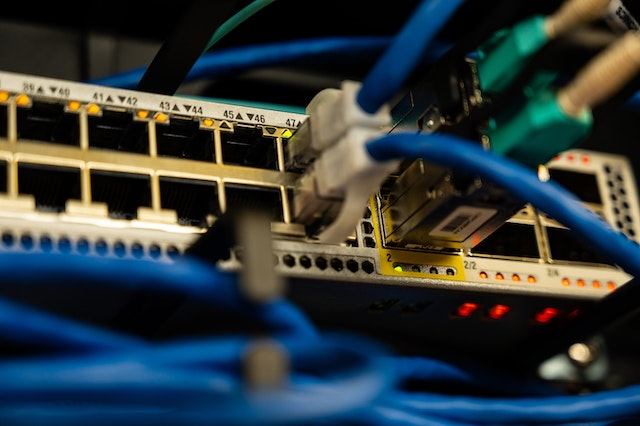Power over Ethernet (PoE) is a networking technology that allows electrical power and data to be transmitted simultaneously over a single Ethernet cable. PoE was developed to simplify the deployment of devices like IP cameras, VoIP phones, wireless access points, and other network devices that require both data connection and power.
- PoE Standards:
The Institute of Electrical and Electronics Engineers (IEEE) has developed several standards for PoE:
- IEEE 802.3af (PoE): The first PoE standard, ratified in 2003, provides up to 15.4 watts of power per port at the power sourcing equipment (PSE) and a minimum of 12.95 watts at the powered device (PD).
- IEEE 802.3at (PoE+): An updated standard, ratified in 2009, delivers up to 30 watts per port at the PSE and a minimum of 25.5 watts at the PD.
- IEEE 802.3bt (PoE++ or 4PPoE): The latest standard, ratified in 2018, defines two types of PSEs, providing up to 60 watts (Type 3) or 100 watts (Type 4) per port.
- Power Sourcing Equipment (PSE) and Powered Devices (PD):
PoE systems consist of two main components: PSE and PD. PSE is responsible for supplying power to the Ethernet cable, while PD is the device that receives and utilizes the power.
- PSE: Typically, PSE devices are network switches or PoE injectors that provide power to the Ethernet cable. PoE switches have built-in PoE capabilities, while PoE injectors are external devices connected between a non-PoE switch and a PD.
- PD: Devices like IP cameras, VoIP phones, and wireless access points that receive power from a PSE and use it for their operation are considered PDs.
- PoE Transmission Modes:
There are two PoE transmission modes: Mode A and Mode B.
- Mode A: Power and data are transmitted over the same wire pairs (1/2 and 3/6 for 10/100 Mbps Ethernet or 1/2, 3/6, 4/5, and 7/8 for Gigabit Ethernet). This mode uses phantom power, a technique where power is superimposed over the data signal.
- Mode B: Power is transmitted over separate wire pairs (4/5 and 7/8 for 10/100 Mbps Ethernet or only 4/5 and 7/8 for Gigabit Ethernet) that are not used for data transmission. This mode uses spare pairs for power transmission.
- PoE Classes and Power Levels:
PDs are classified into different classes based on their power requirements. The PSE negotiates with the PD to determine its class and supply the appropriate amount of power.
- Class 0: 0.44 – 12.95 watts
- Class 1: 0.44 – 3.84 watts
- Class 2: 3.84 – 6.49 watts
- Class 3: 6.49 – 12.95 watts
- Class 4: 12.95 – 25.5 watts (for PoE+ devices)
- Class 5-8: Up to 71.3 watts at the PD (for PoE++ devices)
- Benefits of PoE:
- Simplified installation: PoE simplifies the deployment of network devices by eliminating the need for separate power supplies or electrical outlets near the devices. This can reduce installation costs and complexity.
- Flexibility: PoE allows network devices to be installed in locations where traditional power sources are not available or impractical, such as on ceilings, walls, or outdoors.
- Scalability: PoE-enabled network switches can power multiple devices, making it easier to expand the network infrastructure as needed.
- Centralized power management: PoE allows for centralized power management, which can simplify maintenance and reduce power consumption through features like remote power cycling and power scheduling.
- Safety: PoE systems are designed to protect devices from overloading, underpowering, or incorrect installation. Additionally, PoE operates at low voltages (typically below 60 volts), reducing the risk of electrical hazards.
- PoE Limitations:
- Distance limitation: Ethernet cable length is limited to 100 meters (328 feet) for reliable data transmission, which also applies to PoE. This can be a constraint in large installations, although PoE extenders or repeaters can be used to overcome this limitation.
- Power limitations: PoE standards define maximum power levels that may not be sufficient for some high-power devices. However, this concern is being addressed by newer standards like IEEE 802.3bt, which supports up to 100 watts per port.
- PoE Applications:
- PoE technology is widely used in various applications, including:
- IP surveillance cameras: PoE simplifies the installation of IP cameras by providing power and data connectivity through a single Ethernet cable.
- Wireless access points: PoE enables easy installation and deployment of wireless access points in locations without nearby power outlets.
- VoIP phones: PoE-powered VoIP phones can operate without a separate power adapter, reducing clutter and simplifying installation.
- Network-attached storage (NAS) devices: PoE can power NAS devices, allowing them to be placed strategically without the need for additional power sources.
- IoT devices: Many IoT devices, such as sensors and smart lighting systems, can be powered using PoE, simplifying their deployment and maintenance.
PoE in the Future:
As network devices continue to evolve and require more power, PoE technology will also advance to meet these demands. The development of new PoE standards like IEEE 802.3bt, which can provide higher power levels, is a testament to the ongoing innovation in the field. Additionally, the widespread adoption of IoT devices and smart city infrastructure will likely drive further growth and innovation in PoE technology.
In summary, Power over Ethernet (PoE) is a versatile and efficient networking technology that simplifies the deployment and management of network devices requiring both power and data connectivity. Its continued evolution and adoption across various applications demonstrate its importance in modern networking infrastructure.



